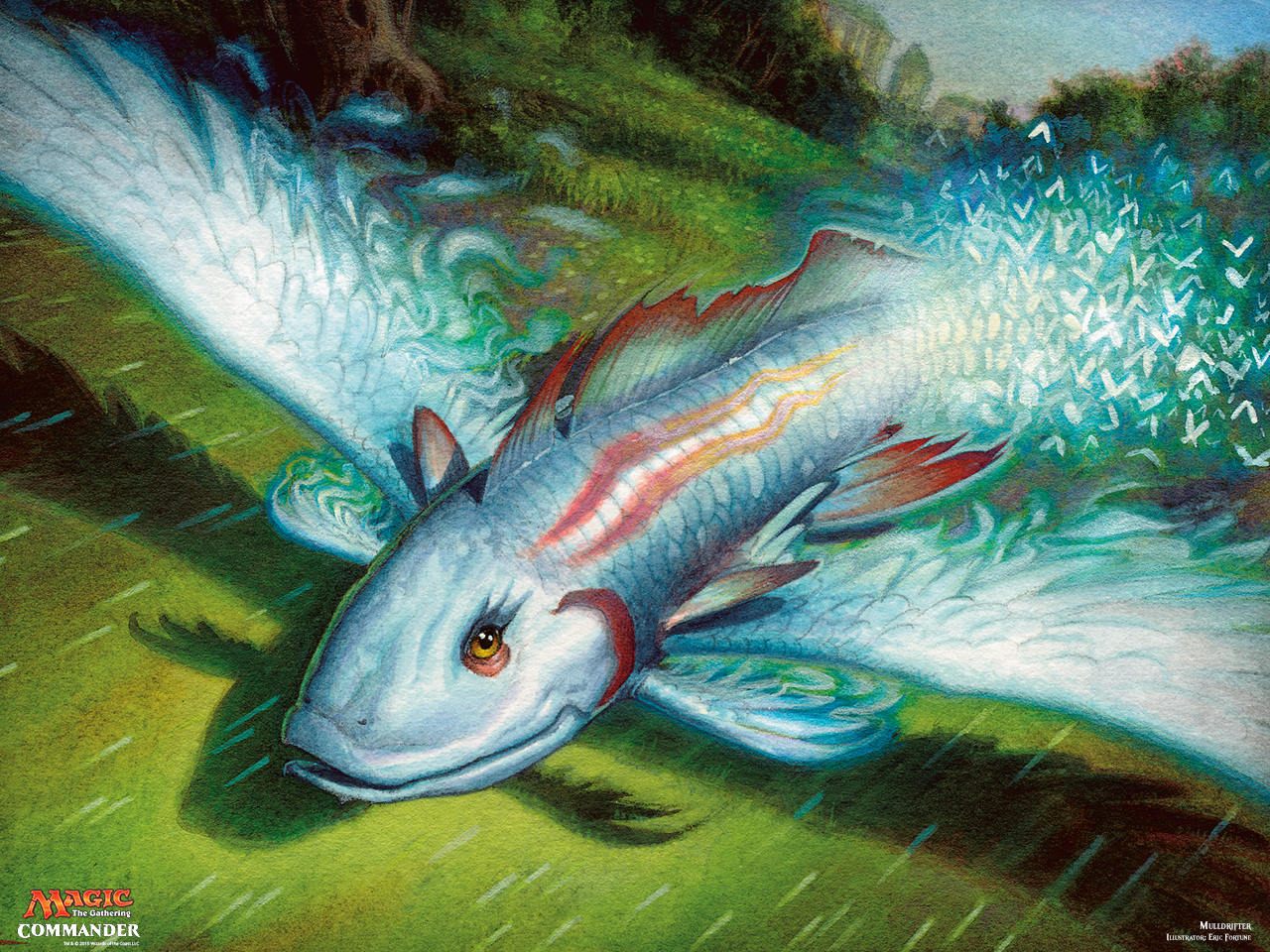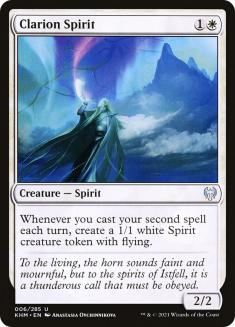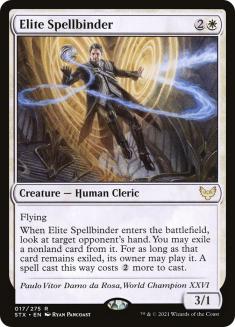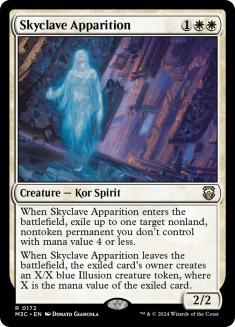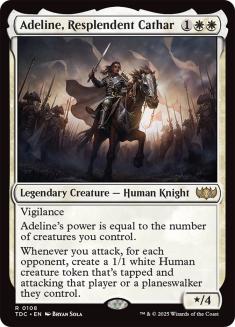Normally I’m the kind of person who frets about their deck choices until the last possible minute. But I’ve learned over the years that it tends to work out better when I give myself some room before the tournament where I’m locked in with my decks and have some time to focus on finding the exact list I want. This is especially true for mixed-format events, where you have to finalize two decklists instead of one.
So after narrowing down my options to six decks across the two formats last week, I spent the weekend looking at metagame trends and locked my deck choices in on Sunday night. Today, I’ll go over what led me to choose the decks I have, and what my current lists look like. I don’t expect these lists will change much over the next few days, but a few cards here or there could shift. Let’s get into it.
Standard: Mono-White Aggro❄
Creatures (32)
- 2 Skyclave Apparition
- 4 Luminarch Aspirant
- 4 Clarion Spirit
- 4 Usher of the Fallen
- 4 Battlefield Raptor
- 4 Monk of the Open Hand
- 3 Brutal Cathar
- 3 Intrepid Adversary
- 4 Adeline, Resplendent Cathar
Lands (23)
Spells (5)

Last week I was leaning more toward Izzet Epiphany; I think the deck is much more powerful than the rest of the format. Ultimately I feel much more comfortable playing an aggressive deck. I believe Mono-White Aggro❄ best exploits the Izzet Epiphany decks as players are building them now.
Notably, I switched from a more normalized list to one featuring a low curve and Clarion Spirit. My experience with Mono-White showed me how much different the games are when you start with a one-drop, even if you sacrifice some individual card quality by registering Battlefield Raptor. All the most powerful cards available to Mono-White, from pump effects like Luminarch Aspirant and Paladin Class to disruptive creatures like Brutal Cathar and Reidane, God of the Worthy, are at their best when they’re pressing an advantage on the battlefield. You need to get started as soon as possible.
Additionally, I’ve noticed that the Izzet Epiphany decks are lower on sweepers than they have been in the past. Many have at most three in their 75, often with two of those in the sideboard. And of the various sweepers they play, Cinderclasm seems to be the least common. Going wide as an aggro deck is the best way to combat an opponent who is relying on spot removal and blockers like Smoldering Egg. Even against Mono-Green Aggro❄, the bevy of flyers this deck can produce are an easy way to close out the game even in the face of their larger creatures.
Once you commit to the Clarion Spirit build, the tough part of coming to a list is which three-drops to play. You don’t have as much space for them as other builds and there are plenty of powerful options. I went with a somewhat unusual split of four Adeline, Resplendent Cathar; three Brutal Cathar; and two Skyclave Apparition. Notably this means zero copies of Maul of the Skyclaves and Elite Spellbinder, though the latter snuck into the sideboard.
Cutting Maul makes sense in this build since you’re trying to go wide, not tall, but Spellbinder is a staple in these decks and for good reason. But I knew I wanted more removal than most Mono-White lists. I’m expecting a lot of Mono-Green Aggro❄ this weekend; further, the Izzet decks have several creatures you want to remove, from Smoldering Egg to Goldspan Dragon to Lier, Disciple of the Drowned. I’m also lower now on Elite Spellbinder than I have been because of the presence of Spikefield Hazard in significant numbers. Having a couple in the sideboard games can be important to snipe a sweeper, but my maindeck is tuned toward the aggro matchups.
On the other hand, Skyclave Apparition is better now than it has been in a while, since the Izzet decks maindeck Smoldering Egg more often than not. The aggro matchups have several noncreature permanents that can be problematic, from Esika’s Chariot to Portable Hole.
It’s tempting to trim an Adeline to make room for something else since it’s a legend, but please don’t. It’s consistently the best card in the deck, dominating battlefields, and either dodges or leaves behind a token in the face of much of the removal in the format.
I built the sideboard on two key principles. First, I want the ability to tweak my disruptive elements to my opponent’s specific archetype, list, and playstyle. That means a wide array of removal and other forms of disruption. Second, I want to include lots of narrowly powerful cheap spells, which always overperform for aggressive decks that need to find a way to power through decks once they’re fully prepared for your creatures. That’s why you see singleton copies of Curse of Silence and You’re Ambushed on the Road, as well as several copies of Portable Hole.
Lastly, I included a single copy of Cave of the Frost Dragon for matchups where I want to side out the Kabira Takedown but still have 24 lands. Takedown is a nice, versatile card to have, but it’s not reliable against the control decks once they have all their removal and sweepers, where an additional creature-land can make a significant difference, even if it’s the worst of the cycle.
The numbers here could shift a little before Friday, but I think this list is structurally sound so long as the Standard metagame breaks the way I think, with Mono-Green Aggro❄ as the most popular deck and Izzet Epiphany decks skimping on sweepers.
Modern: Esper Reanimator
Creatures (14)
Planeswalkers (3)
Lands (21)
Spells (22)

If you had asked me last week which of the four Modern decks I was thinking about I was least likely to play, I would’ve answered Esper Reanimator. But two realizations made it rise from fourth to first on my list in the span of a few days.
First, was the fact that this is the first major SCG event in nearly two years, and card availability is going to be a major concern. That means that the Modern metagame is going to be much more variable than the online metagame. Consequently, linear decks are a tough choice to make, because you can’t rely on the same holes in the metagame that they exploit online. So I gave up on Gruul Belcher and Dredge as viable options. Were this event happening online, I likely would’ve registered the former unless I saw dedicated hate rise in the metagame.
So that left me with the choice between Four-Color Indomitable Creativity and Esper Reanimator, two combo-control decks with plenty of flexible answers, thus making them excellent choices for a wide-open field. And I was leaning towards Creativity until Saturday, when this happened:
A player of aspiringspike’s caliber winning a Challenge, against a stacked Top 8, with a new build of one of my top two choices was a game-changer. Grief and Solitude replaced Thoughtseize and Counterspell, with Ephemerate as another option to generate card advantage and win a game outside the graveyard.
I knew that Mulldrifter, as awkward as it looked, was a good addition, because it gave the deck other uses for its reanimation package, thereby making the deck more consistent. But having a few inefficient Divinations isn’t enough to build an entire control gameplan around. So while the old lists looked like a true combo-control deck, the control aspect was lacking. This exacerbates the vulnerability to graveyard hate since you’re relying too heavily on the combo aspect to carry the deck.
Now Mulldrifter is just part of the control aspect, which in reality revolves around Ephemerate. Not only is Ephemerate a powerful card, especially in combination with the Incarnations and Mulldrifter, it also doubles as a protection spell for Archon of Cruelty against spot removal. In any hybrid strategy, you need to have cards that play roles in both plans. Otherwise you don’t have enough space to flesh out each aspect. Having your key control card also play well when you’re acting like a combo deck is a huge gain.
I was also excited about this deck because of how well it utilizes Grief. It may have been the most overhyped card from Modern Horizons 2, but it’s clearly still powerful in the right shell. Living End has been the only real home until now, because the various Grief-Ephemerate shells people have played simply aren’t good decks. They’re hodgepodges of midrange cards that are chosen specifically to enable playing the powerful synergy between those two cards. And make no mistake, Turn 1 Grief-Ephemerate is still an excellent play.
I spent some time combing over Spike’s list. The only change I wanted to make was to bring the fourth Prismatic Ending back into the maindeck since I’m expecting more Ragavan, Nimble Pilferers; Dragon’s Rage Channelers; and Goblin Guides this week than we see online. The third Mulldrifter is the most expendable card in the maindeck since Ephemerate is already a two-for-one, so that was the easy cut.
As far as the sideboard, I knew I wanted a counterspell to help out against control and linear strategies, so I went with the reliable Dovin’s Veto. Had there been more creature-combo in the metagame, I would’ve gone for Drown in the Loch. The rest of the sideboard looks excellent, though I’m not sold that you need four copies of Leyline of the Void. That said, Leyline is great in this deck since Faithless Mending lets you turn dead copies into new cards.
I expected the manabase to be a place where I could find improvement, but even that was well-built. The singleton Glacial Fortress looks awkward, but you want another blue source and I’d rather have a single checkland than the fourth fastland when you don’t need blue mana on Turn 1 for any of your spells. Similarly, the second Watery Grave looked awkward but you can’t cut a blue or black source. Maybe it will turn into a Drowned Catacomb, but with a low land count you really want to avoid the awkward fastland + checkland starts. You could also play another Polluted Delta over it, but this deck wants to get to eight actual lands rather often to hard-cast Archon of Cruelty, so you can’t raise your fetchland-to-fetchable land ratio too much.
Horizon lands are another consideration, but they aren’t appropriate here for two reasons. First, this deck has a low land count and Faithless Mending to mitigate flood, so you won’t often find yourself in situations where you want to sacrifice it, while you’ll often be forced to play it early in land-light hands and take plenty of damage. Second, Burn is a good deck in the metagame and relatively easy to put together, both because of price and a low number of recently printed cards. I expect it to be significantly overrepresented, so I’m going to bias my manabase away from lands that lower my life total.
Onward To SCG CON
With how much gathering is going on around the tournament itself this weekend, it’s nice to have the Magic part of my weekend pretty well in hand. And I feel good about playing two decks with proactive plans that can end a game quickly, yet are plenty resilient and more than capable of winning games on Turn 10. That’s a recipe for success in open metagames, and no one knows exactly what to expect metagame-wise for this tournament.
Now I just have to acquire the physical cards. It’s been a while — anyone know a good place to buy Magic cards?

